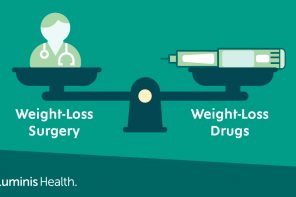Childhood obesity is a debilitating disease that can affect children physically and mentally. As a child, it’s easy to gravitate toward snacks that come in bright, colorful wrapping or grab a tasty, sugary drink without thinking much of the long-term effects. But, if your child combines consistent poor diet choices with other factors, this can lead to childhood obesity.
Childhood obesity is a growing epidemic in the U.S., with the percentage of children and adolescents affected by obesity tripling since the 1970s. Data shows one in five school age children and young people in the U.S. has obesity, making it the most common chronic disease of childhood, according to the Centers for Disease Control and Prevention.
Parents should be aware of factors that contribute to childhood obesity. These include genetics, metabolism, eating behaviors and physical activity, sleep schedule and negative events that a child might have experienced.
There are health risks linked to childhood obesity that can have a harmful effect on the body in more than one way. Obese children can experience high blood pressure and cholesterol, diabetes, breathing problems and joint discomfort, among other conditions. Obese children are also susceptible to psychological problems, such as depression, anxiety and low self-esteem.
It’s important that you help your child develop a healthy relationship with food from the very beginning. My best advice for parents and guardians is to keep it practical, primarily focusing on nutrition and physical activity. Here are some steps in preventing childhood obesity:
- Develop a healthy relationship between a child and food. Focus on the health factor, not the body factor to prevent developing a negative relationship between a child and food. Be careful how you talk about weight. Tell your child you want to help them focus on eating foods that are healthy.
- Eat healthy. Eating five or more servings of fruits and veggies per day can reduce the risk of heart attack, stroke, cancer and early death.
- Get more hours of exercise per day. I recommend 60 minutes every day. This includes walking or any other aerobic activity. An easy way to make exercise fun is for your child to get involved in a team sport, play with other children in the park or go biking. If you yourself practice this, your child will be more likely to do it and develop it as a habit. Remember, they look up to you!
- Stay away from sugary drinks and snacks. Focus more on the produce aisle and stay away from high sugar drinks and high calorie snacks. Limit these to special occasions so your child begins to develop the habit of having these every once in a while and not as frequently. Instead, try a new fruit or vegetable every month.
- Practice mindful eating. We tend to eat more when we’re distracted. Instead of watching TV, practice mindful eating and being present. This also allows for more family time and having conversations with each other.
- Sleep. This is very important. If your child sleeps less than nine hours a night, he or she is more likely to be obese. Make sure your child has a regular sleep schedule. This will also help your child have the energy he or she needs to get through the day.
If needed, consider seeing a nutritionist. It won’t be an overnight change, but you can start by changing your child’s diet and encouraging healthy weight loss (no more than two pounds a week if they’re a child or adolescent, and no more than one pound per month if they’re between two and five to make sure they get the nutrition they need to grow). When you make these little changes, you’re setting them up to make good decisions for the rest of their lives.

Deon Edgerson-George, MD, is an internal medicine physician and pediatrician at Anne Arundel Medical Group (AAMG) Eastern Shore Primary Care.




